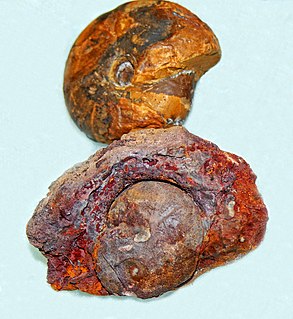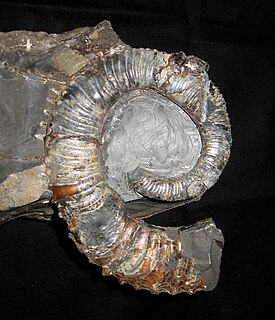Arkanites is a goniatitid ammonite that lived during the Early Pennsylvanian that has been found in Arkansas and Oklahoma in the U.S.
Aristoceratoides is an extinct ammonoid genus belonging to the goniatitid family Thalassoceratidae that lived during the Middle Permian. Named by Ruzhentsev, 1960, the type species is "Thalassoceras" varicosum Gemmellaro, 1887.
Armatites is an Upper Devonian goniatitid included in the tornoceratid family. The shell, or conch, is discoidal, with flattened flanks, a flattened venter with a double keel, and a deep ventral sinus, but without ventrolateral grooves. The lateral saddle of the suture is broad. Armatites is known from the Upper Devonian (Fammenian) of Canning Basin in Australia. The subfamily in which it is included, the Aulatornoceratinae is also known from France with the genus Aulatornoceras.
Baschkirites is an extinct cephalopod genus belonging to the ammonoid order Goniatitida that lived during the Early Carboniferous (Bashkirian).
Donetzoceras is a genus belonging to the goniatitid family Gonioglyphioceratidae ; extinct ammonoids which are shelled cephalopods more closely related to squid, octopus and other coleoids than to the superficially similar Nautilus
Beyrichoceras is a genus belonging to the Goniatitid family, Muensteroceratidae, a group of ammonoids, extinct shelled cephalopods related to belemnites and recent coleoids and more distantly to the nautiloids

Beyrichoceras is a genus belonging to the Goniatitid family, Maxigoniatitidae that lived during the Mississippian Period
Ussuria is a genus of Lower Triassic ammonites with a smooth, involute discoidal shell with submonophyllic sutures, belonging to the ceratitid family Ussuriidae.
Falcitornoceratinae is one of three subfamilies of the Tornoceratidae family, a member of the Goniatitida order. Shells produced are extremely involute and have no umbilicus. Young and intermediate whorls have ventrolateral grooves. The adventitious lobe, which develops ontogenetically between the external, or ventral, and lateral lobes, is widely rounded. Tornoceratids in which the Falcitornoceratinae are included are involute, subdiscoidal, with sutures that form 6 to 10 lobes.

Clymenia is a genus in the ammonoid order Clymeniida, restricted to the Upper Devonian, characterized as with all clymeniids by a dorsal siphuncle that runs along the inside of the whorls, unusual for ammonoids.

Exiteloceras is an ammonite genus from the Late Cretaceous.

Clyclolobus is a smooth, essentially involute subdiscoidal goniatitid ammonoid that has sutures with a bifurcate ventral lobe, flared outwardly at the end, in which the halves may be secondarily trifurfate, ending in sharp, narrow projections. Lateral sutural elements follow an acuate line that swings first to the front, then sharply to the rear before becoming hidden by the next whorl. Saddles are narrow, cumulous in appearance with short, irregular, rounded sub-endings. Ventro-lateal lobes are trifurcate with pointed, thorn-like projections.
Pseudonautilidae is a family of Jurassic and Lower Cretaceous nautilid cephalopods belonging to the same superfamily as modern Nautilus, Nautilaceae, but forming a different branch from the family Nautilidae. Pseudonautilids, together with other nautilids, were contemporary with the ammonoids, which comprise an entirely different set of shelled cephalopod stocks more closely related to octopus and squid.
Doulingoceras is a genus of ammonoid within the ceratitid order, found in China, that lived during the Late Permian during the time span from about 260.5 to 254 million years ago. The genus is included in the family Paraceltitidae, which belongs to the superfamily Xenodiscaceae.
Biloclymenia is a genus in the ammonoid order Clymeniida which is characterized by a dorsal retrosiphonitic siphuncle with long adapically pointing septal necks.
Gundolficeras is member of the Tornoceratidae,, from the Late Devonian named by Becker, 1995 and assigned to the Falcitornoceratinae. The type species is "Lobotornoceras" bicaniculatum.
Neoglaphyrites is a gonititid ammonite that lived during the latest Pennsylvanian and early Permian. Its shell is ellipsoidal and moderately involute; the umbilicus deep and typically less than 15 per cent of the shell diameter but in some species closer to 20 per cent. Delicate growth lines forming ventral and lateral sinuses and ventrolateral and dorsolateral salients have been found on Canadian Arctic specimens. The suture is characterized by the ventral lobe split into two broad prongs that are separated by a high median ventral saddle; prongs closely approximate the width of the first lateral lobe. The first lateral saddle is evenly rounded and is nearly symmetrical. The umbilical lobe is V-shaped and internal lobes are deep and narrow.

Neocomites is a genus of ammonite from the Lower Cretaceous, Berriasian to Hauterivian, and type genus for the Neocomitidae.
Eowellerites is genus of ammonoid cephalopods belonging to the Welleritidae family. Species belonging to this genus lived in middle Pennsylvanian (Moscovian). Its fossils were found in USA and Japan. It had thinly discoidal shells with a quite wide umbilicus (U/D = 0.3 - 0.5). While in juvenile stages (up to 15 mm in diameter) venter is moderately rounded, it becomes slightly rounded to flattened when becoming mature (100 mm in diameter). 12-lobed suture has adventitious lobe on the first lateral saddle and is also characterized by an addition of an umbilical lobe. Sutural formula is (V1 V1) L1 L (U1 U2): I D. It has evolved from Winslowoceras henbesti and gave rise to genus Wellerites.
Linguatornoceras is genus of ammonoids that lived during Devonian period. Animals belonging to this genus had discoidal shells with no umbilicus and moderately high aperture. On the venter, conch is rounded or flattened. There might be ventro-lateral grooves and constrictions. Growth lines are biconvex. Suture has deep adventitious lobe which is closely tongue-shaped and subacute. Their fossils were found in Australia, Germany and Russia.




